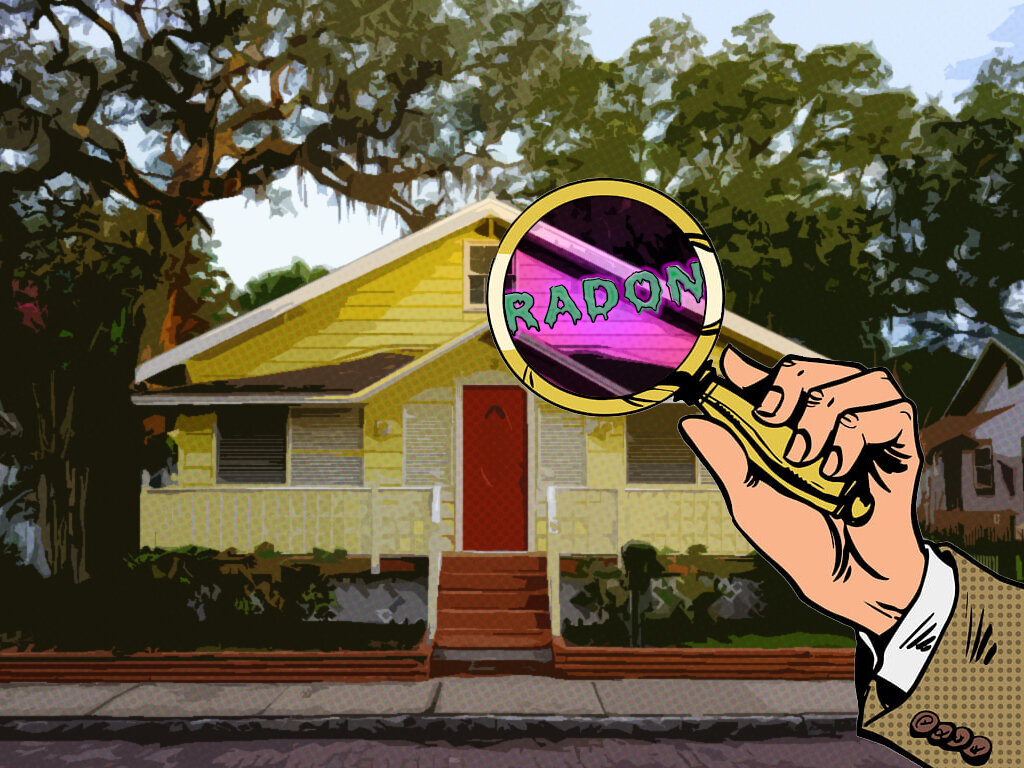I’ll admit it. At first, I did not fully understand what radon was until after I bought my first home. As a first-time homebuyer that’s a normal case, so you’re not alone. Possibly you are a veteran homeowner and didn’t know what radon was until clicking on this article and that is alright as well. However, I’m grateful to be able to share with you this information, because awareness about radon gas and testing saves lives.
-
What is Radon?
Radon is a naturally occurring radioactive gas that is produced by the decay of radium, an element found in most soils. Radon is released from soil and rocks and moves as a gas through the soils at different rates and distances depending on the porosity of the soil and other geological and atmospheric characteristics. If at the surface radon gas encounters an enclosed structure such as a home or a building, radon permeates through cracks and openings in the floor into the structure where it accumulates and decays further into other radioactive elements. Outdoors radon is not a health concern because it rapidly dilutes in the atmosphere to very low levels but inside a home, it becomes trapped. You can’t see it, smell it or taste it and your body cannot sense that it is there. Radon is also a Class-A carcinogen proven to cause lung cancer in humans. In fact, the Surgeon General of the United States has warned that radon is the second leading cause of lung cancer.
Why should you test for Radon?
According to Florida’s Health Department, “Radon is responsible for more than 21,000 lung cancer deaths a year (one every 25 minutes). In Florida, one in five homes tested has elevated radon levels above the action level of 4 pCi/L.” Now that’s definitely a health concern worth discussing. We spend on average more time in our home than anywhere else in our daily lives.
The EPA Recommends the Following:
-
If you are buying or selling a home, have it tested for radon.
-
For a new home, ask if radon-resistant construction features were used and if the home has been tested.
-
Fix the home if the radon level is 4 picocuries per liter (pCi/L) or higher
-
Radon levels less than 4 pCi/L still pose a risk and, in many cases, may be reduced.
Except from EPA402/K-13/002 |March 2018 (revised)
When Should I Test For Radon with a Home Purchase?
In regards to real estate transactions; performing a radon test can occur before, during, or well after the transaction. However, it’s in everyone\’s best interest to address radon concerns early in a real estate transaction. Luckily there are many businesses and individuals that can help. In the state of Florida, all businesses and individuals offering radon sampling, measurement interpretation, or mitigation services must be certified by the Florida health department.
Where can I learn more about Radon?
-
1-800-SOS-RADON
-
Your Real Estate Agent
Who is HomeShape, you might ask? HomeShape is a state-licensed Home Inspection company based in Sanford, FL. Our blog has been recognized for its unique approach topics about home maintenance and extensive resources for homeowners and real estate agents.
-
Schedule a home inspection today on our website!
[av_button_big label=\’Schedule Your Inspection\’ description_pos=\’\’ icon_select=\’yes-left-icon\’ icon=\’ue8ac\’ font=\’entypo-fontello\’ link=\’manually,#scheduleinspection\’ link_target=\’\’ title_attr=\’\’ size-text=\’\’ av-desktop-font-size-text=\’\’ av-medium-font-size-text=\’\’ av-small-font-size-text=\’\’ av-mini-font-size-text=\’\’ margin=\’\’ margin_sync=\’true\’ padding=\’\’ padding_sync=\’true\’ av-desktop-margin=\’\’ av-desktop-margin_sync=\’true\’ av-desktop-padding=\’\’ av-desktop-padding_sync=\’true\’ av-medium-margin=\’\’ av-medium-margin_sync=\’true\’ av-medium-padding=\’\’ av-medium-padding_sync=\’true\’ av-small-margin=\’\’ av-small-margin_sync=\’true\’ av-small-padding=\’\’ av-small-padding_sync=\’true\’ av-mini-margin=\’\’ av-mini-margin_sync=\’true\’ av-mini-padding=\’\’ av-mini-padding_sync=\’true\’ color=\’theme-color\’ btn_custom_grad_direction=\’vertical\’ btn_custom_grad_1=\’#000000\’ btn_custom_grad_2=\’#ffffff\’ btn_custom_grad_3=\’\’ btn_custom_grad_opacity=\’0.7\’ custom_bg=\’#444444\’ color_hover=\’theme-color-highlight\’ custom_bg_hover=\’#444444\’ color_font=\’theme-color\’ custom_font=\’#ffffff\’ color_font_hover=\’white\’ custom_font_hover=\’#ffffff\’ border=\’\’ border_width=\’\’ border_width_sync=\’true\’ border_color=\’\’ border_radius=\’\’ border_radius_sync=\’true\’ box_shadow=\’\’ box_shadow_style=\’0px,0px,0px,0px\’ box_shadow_color=\’\’ hover_opacity=\’\’ sonar_effect_effect=\’\’ sonar_effect_color=\’\’ sonar_effect_duration=\’1\’ sonar_effect_scale=\’\’ sonar_effect_opac=\’0.5\’ id=\’\’ custom_class=\’\’ template_class=\’\’ av_uid=\’av-2i351d\’ sc_version=\’1.0\’ admin_preview_bg=\’\’][/av_button_big]








